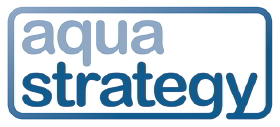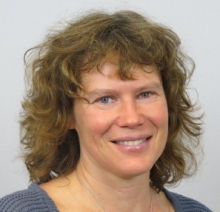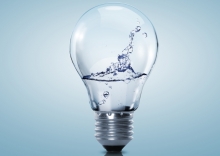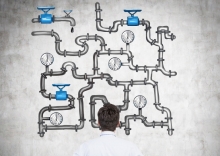Issue:
SWAN, the Smart Water Networks Forum, is stepping up its efforts to promote smart, data-driven technologies in the water sector, with new resources, new groups, and its latest conference set to take place in April. Keith Hayward heard about progress from Amir Cahn, the Forum’s Director of Research and Business Development.
Water utilities face an ever-increasing array of potential ways to collect data and feed it into their decision-making. One of the earliest, and probably most significant, contributions from the Smart Water Networks Forum (SWAN) was to create a framework to help utility managers see how to turn this potential into coherent approaches for their own organisations.

SWAN devised a five-layer architecture to describe smart water systems (see panel below). It then created an interactive tool to allow utilities to work through this and overcome misunderstandings about just what a smart water network is. ‘We had utilities all over the world using it, and getting benefits,’ comments Amir Cahn, SWAN’s Director of Research and Business Development.
The framework also gives technology suppliers a way to position what it is they provide in the eyes utility clients. SWAN has since built on this dual foundation, expanding its network and activities, and this year sees its sixth annual conference, which will be held in London on April 5-6. It has also recently expanded the resources utilities can access on its website to help them begin to look at smart water, while at the conference SWAN is set to launch a new task group focused on one of the key issues upon which further progress for smart water depends.
The interactive tool
The SWAN Interactive Architecture Tool, to give it its full name, was founded on an international survey of 33 utilities, explains Cahn. ‘The goal of the tool is to bridge the business case gap of what it means to successfully adopt a smart water network. Every utility has unique business drivers, unique challenges, and there is no one size fits all solution.’
The tool itself is vendor neutral, but with case studies available for specific examples. Cahn says that reaction to the tool ranged from, for example, a Brazilian utility gaining an understanding of what smart means, through to a more advanced UK utility which saw value in how the utility-driven case studies provided context for the tool. ‘It applies to utilities at different levels of advancement,’ he adds.
Alongside the tool, SWAN devised the Swan Smart Score, which uses 13 multiple choice questions to allow a utility to assess for itself how well it is taking advantage of existing technologies. ‘The whole point of the tool was to take a utility on a smart water journey,’ says Cahn.
Earlier this year, SWAN took the decision to make the web-based tool available to anyone, not just its members.

More case studies and user testimonials were added. A new solutions provider page allows utilities to navigate through a database of smart water technologies. Also, a social forum allows users to submit questions that will be answered by a SWAN expert. ‘Originally it was more of an educational tool. Now it is also more to learn about the industry,’ says Cahn.
A conference to contribute to smart optimism
The line-up for the forthcoming conference includes speakers from global water utilities, as well as regulators, investors, suppliers, and others such as customer service organisations to expand the discussions. ‘The theme of the conference is accelerating smart water, and we expect this to be our largest and most exciting conference to date,’ adds Cahn.
Cutting-edge issues are up for discussion, with a mix of utilities, companies and academics participating in the panels. Themes include cyber security, water quality, and the issue of how to increase innovation in the sector. A special panel, with speakers from China, India and Brazil, will focus on the role of smart water in emerging economies. Another of the themes will be interoperability. ‘This is a key issue that everything revolves around, getting systems to talk to each other,’ says Cahn. It is important both for water utilities, so that they can adopt smart technologies, and for suppliers, so that their technologies can fit into utilities’ systems.
‘Interoperability is a huge issue which SWAN is going to devote a new working group to,’ says Cahn. The group will be launched at the conference, and the founding members will be wireless telecoms company Qualcomm, utility DC Water, and consultant CH2M. ‘The goal of this work group is really to advance the functionality and interoperability in smart water systems,’ he adds.
Cahn hopes that the collective discussions at the event will contribute to an understanding of the best way to progress with smart water networks. He hopes also that the exchanges will have a positive impact for participants. ‘Definitely we want to achieve a sense of optimism,’ says Cahn, adding: ‘We also want people to become leaders in their home country – to take the knowledge they gained, apply it in their company or utility, and promote the industry from within.’
For more details on the SWAN Forum, and for details of the forthcoming conference, visit www.swan-forum.com.
The SWAN smart network architecture
SWAN’s smart water network architecture features five layers.
The physical layer comprises the components for delivering water, i.e. pipes, pumps, valves, pressure reducing valves (PRVs), reservoirs and delivery endpoints.
The sensing and control layer comprises equipment and sensors that measure parameters such as flow, pressure, water quality, reservoir levels, water temperature, acoustic information, etc., and equipment for the remote control of components of the network, such as pumps, valves, and pressure-reducers.
The next layer is the collection and communications layer, which does not have direct contact with water. It includes, for example, data loggers, SCADA, AMI (advanced metering infrastructure), and other data transfer technologies. The layer does not create data, and does not carry out significant data processing.
The next layer is the data management and display layer, which allows for operator interaction. It includes data repositories, GIS or network visualisation tools, water balance applications, and fixed-rule feedback automation.
The final layer is the data fusion and analysis layer, where more sophisticated processing of raw data occurs. This may include, for example, hydraulic modelling systems, network infrastructure monitoring, smart pressure management, and smart (not fixed feedback) pumping or energy optimisation systems.
Source: ‘A layered view of data technologies for the water distribution network’, SWAN Forum
Keywords:
- smart water utilities, water supply, smart network monitoring






